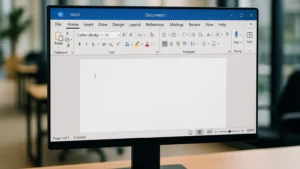Last Updated: January 24, 2025
In today’s fast-paced digital world, efficiency is paramount. Whether you’re drafting a report, editing a manuscript, or preparing a presentation, time is of the essence. Microsoft Word, the go-to word-processing tool for millions, offers a range of features designed to enhance productivity. Among these, keyboard shortcuts are one of the most effective ways to streamline your workflow and save valuable time.
In this article, we’ll explore the most essential Microsoft Word shortcut keys that can transform the way you work. We’ll address frequently asked questions, provide valuable insights into why and how to use these shortcuts and ensure you walk away with practical tips to boost your productivity. Whether you’re a seasoned Word user or just getting started, this guide is your key to mastering Word like a pro.
Table Of Contents
Why Use Microsoft Word Shortcut Keys?
Before diving into the list of shortcuts, let’s first understand why they’re so valuable:
- Speed Up Your Workflow: Shortcut keys eliminate the need to navigate through multiple menus, allowing you to perform tasks faster and more efficiently.
- Reduce Repetitive Strain: Constantly moving between the keyboard and mouse can cause strain. Using shortcuts minimizes this back-and-forth, making your workday more comfortable.
- Improve Focus: With shortcuts, you can keep your hands on the keyboard and your eyes on the screen, reducing distractions and maintaining your focus on the task at hand.
- Boost Accuracy: Performing tasks with shortcuts reduces the risk of misclicks or errors, ensuring that your work is more precise.
Frequently Asked Questions About Microsoft Word Shortcut Keys
1. What Are the Most Commonly Used Shortcut Keys in Microsoft Word?
Here’s a list of the most commonly used shortcut keys that every Word user should know:
- Ctrl + C: Copy the selected text or object.
- Ctrl + V: Paste copied text or object.
- Ctrl + X: Cut selected text or object.
- Ctrl + Z: Undo the last action.
- Ctrl + Y: Redo the last action.
- Ctrl + S: Save the current document.
- Ctrl + P: Open the Print dialog box.
- Ctrl + F: Open the Find dialog box to search within the document.
- Ctrl + B: Bold selected text.
- Ctrl + I: Italicize selected text.
- Ctrl + U: Underline selected text.
2. How Can I Memorize These Shortcut Keys?
Memorizing shortcut keys can be challenging at first, but with practice, it becomes second nature. Here are a few tips to help you remember them:
- Group Similar Shortcuts: For example, all formatting shortcuts (Ctrl + B for Bold, Ctrl + I for Italics, Ctrl + U for Underline) follow a similar pattern.
- Use Them Regularly: The more you use shortcut keys, the more familiar they become. Try to incorporate them into your daily workflow until they feel natural.
- Create a Reference Sheet: Keep a printed or digital list of essential shortcuts nearby. Over time, you’ll find that you rely on the reference sheet less and less.
Yes! Here are some of the most useful navigation shortcuts:
- Ctrl + Home: Move the cursor to the beginning of the document.
- Ctrl + End: Move the cursor to the end of the document.
- Ctrl + Arrow Keys: Move the cursor word by word or paragraph by paragraph.
- Ctrl + Page Up/Page Down: Scroll quickly through the pages.
These shortcuts allow you to navigate large documents quickly, making it easier to edit and review content.
Advanced Microsoft Word Shortcut Keys for Power Users
For those looking to take their Word skills to the next level, here are some advanced shortcuts:
- Alt + Shift + D: Insert the current date.
- Alt + Shift + T: Insert the current time.
- Ctrl + Shift + F: Change the font.
- Ctrl + Shift + > or <: Increase or decrease font size.
- Ctrl + Alt + 1/2/3: Apply Heading 1, 2, or 3 styles.
Why These Shortcut Keys Matter
Using these advanced shortcuts can significantly boost your productivity, especially if you frequently work on complex documents. They help you perform actions faster, maintain consistency in formatting, and keep your workflow smooth.
Real-Life Application of Microsoft Word Shortcut Keys
Imagine you’re working on a lengthy report that requires frequent revisions. Instead of manually navigating through menus to apply formatting or search for specific sections, you can use shortcut keys to:
- Quickly copy and paste sections (Ctrl + C, Ctrl + V).
- Undo and redo changes (Ctrl + Z, Ctrl + Y).
- Navigate to different parts of the document (Ctrl + Home, Ctrl + End).
By integrating these shortcuts into your daily routine, you can cut down on the time spent on repetitive tasks, allowing you to focus on the content itself.
Common Mistakes to Avoid
1. Overlooking the Power of Customization
While the default shortcuts are incredibly useful, Microsoft Word also allows you to customize your own shortcuts. If you find that certain actions are frequent but not covered by existing shortcuts, consider creating your own to further streamline your workflow.
2. Ignoring Lesser-Known Shortcuts
Many users stick to the basics, but exploring and mastering more advanced shortcuts can offer significant productivity gains. Take the time to learn and experiment with these shortcuts to discover which ones best suit your workflow.
3. Not Practicing Enough
Like any skill, using shortcut keys effectively requires practice. Don’t get discouraged if you don’t memorize them all at once—consistent practice will make them second nature.
Conclusion
Mastering Microsoft Word shortcut keys is one of the simplest yet most effective ways to enhance your productivity. By incorporating these shortcuts into your daily workflow, you can save time, reduce strain, and focus more on creating high-quality content. Whether you’re a beginner or a seasoned Word user, these shortcuts are the keys to unlocking your full potential in document processing.
Take the time to learn and practice these shortcuts, and you’ll find that they become an invaluable part of your toolkit. Happy typing!






Pingback: How to Customize Keyboard Shortcuts in Microsoft Word - MSW Tutor.